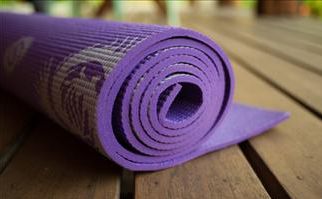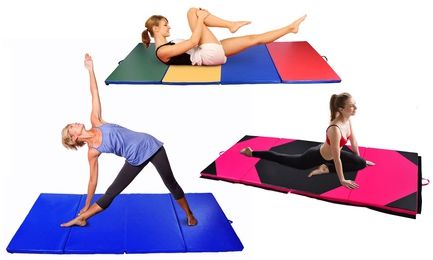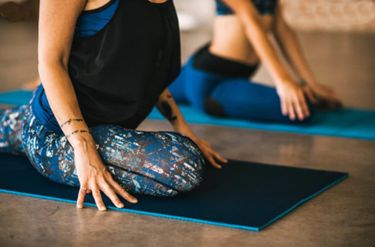Home » Exercise Mats » Yoga Mat vs Exercise Mat – Are you tired of slipping and sliding during your yoga practice? Or maybe you’re sick of your exercise mat feeling like a thin piece of cardboard under your feet. Well, fear not my fellow fitness enthusiasts, because today we’re tackling the age-old debate of yoga mat vs exercise mat. It’s a battle of the mats, and we’re here to determine which one reigns supreme. Will the yoga mat’s sticky surface and cushioned support come out on top? Or will the exercise mat’s durability and versatility win the day? Get ready to roll out your mat and let the games begin!
Yoga Mat VS Exercise/Workout Mat – Everything You Need to Learn
Here are some major differences between a yoga mat and an exercise mat.
Thickness of Mats
 For yoga activities, you generally do not need much protection from the ground since you would not be making impact movements. However, while doing the squats and push-ups, chances are you might end up hurting yourself if you do not have a mat of considerable thickness.
For yoga activities, you generally do not need much protection from the ground since you would not be making impact movements. However, while doing the squats and push-ups, chances are you might end up hurting yourself if you do not have a mat of considerable thickness.
This one basic difference between the two mats will compel a wise person to definitely get a separate mat if they are into both aerobics. Yoga mats have a standard thickness of 1/8th of an inch. On the other hand, exercise mats go over the variation of 1/2 inch or to a complete inch at the maximum.
Material Matters a Lot
Most yoga mats are made up of PVC material. The material selection has been made, keeping in view some typical pick points:
- The PVC material is light enough to ensure your body has a connection with the hard floor while you sit upon it for meditation.
- The second reason is the easy cleaning of the PVC material.
- Yoga and mind relaxation activities need not necessarily be done inside the home. Sometimes you would have to take the mat with you outside when you feel like doing yoga outdoors under the sun’s rays.
- PVC material does not produce any bad odor when kept under the sun for a certain duration of time. These are the major reasons for material selection.
Considering exercise mats, you would find most of the good quality fitness mats to be made of rubber. The foremost reason is their soft cushioning that can be felt as much enhanced in rubber as compared to PVC.
Also, rubber develops a strong connection with your feet, and while doing the flexible tasks, your feet would not lose support or slip away from the fitness mat.
There are people who sweat a lot while doing yoga and this results in slipping of hands and feet. For such sweaty guys, it is important that they should consider a mat that is made of closed-cell technology. This technology makes the mat sweat resistant and hence provides a better grip.
The Protection Aspect
 Yoga mats are engineered in a way that not much attention is paid to the consequences in case of trips or falls. This is because postures are not much intense, and you rarely ever trip while doing yoga poses.
Yoga mats are engineered in a way that not much attention is paid to the consequences in case of trips or falls. This is because postures are not much intense, and you rarely ever trip while doing yoga poses.
On the other side, exercise mats definitely need to give you an extra level of protection against injury in case of falls. They need to be soft and firm so that your body does not get intact with the ground, and you do not face any joint or muscle injury.
If your exercise mat is thinly cushioned, this means it is not designed for heavy-duty workout activity but is just for beginners. Make sure to know your mat and its correspondence to your body before starting to exercise on it.
Restriction Free Movement
 Exercise mats are designed to give maximum firmness to your body and feet. If the exercise mat lacks this essential feature, it may be of no use to you at all.
Exercise mats are designed to give maximum firmness to your body and feet. If the exercise mat lacks this essential feature, it may be of no use to you at all.
Considering yoga mats, flexibility is an important property that needs to be there. A yoga mat should provide you ease in movements with zero restriction to any kind of pose. If the mat offers even a slight restriction, it might result in disturbing the entire meditation equilibrium that you would have been trying to maintain for hours.
So, be sure to check if your yoga mat restricts any movements, or is it designed in a way to facilitates you with every posture.
Mat’s Durability
I would not put this under the ‘differences’ title but instead beneath the ‘similarities’ while discussing, ‘Yoga Mat VS Workout Mat’.
Almost both of them have been tried and tested to possess the same design life. However, this factor also depends upon your use of duration and maintenance level. If you are someone who takes really good care of your mat, it may last you for an extra 6 months than its design life.
Contrary to that, if your mat gets used a lot, and there is no proper cleaning and maintenance, it would not serve you for a longer period of time. So, it all depends upon you and yes, of course, the mat you are going to invest in. Because after all, YOU GET WHAT YOU PAY FOR!
Dimension Factor
Another thing I would like to drop by while bringing this article to an end is the dimension aspect! However, most of us might not notice it, but those who go to gyms and fitness centers on a regular basis would observe this very well. Exercising mats come in large dimensions, wide enough to cover a small room. Whereas yoga mats come in single-person use dimensions. The reason is obviously very clear!
Yoga is not done in groups or in between people and crowds, whereas you can obviously share your exercise mat with your friends or your gym mates. Also, for doing moment and rotation exercises, you would obviously require a larger dimension exercise mat. Yoga activity does not need any such kind of larger mats; hence the size is kept smaller to serve one person only, by default.
What is the difference between a yoga mat and a Pilates mat?
As we all are well aware that yoga activity focuses more on improving your body’s flexibility and allowing it to stretch more in different directions. Pilates, whereas’ focuses on relaxing your tensed muscles and providing them with more strength. Mats for both activities are designed, keeping in view their basic serving properties.
A yoga mat has to be thin enough to let your body develop a connection with the ground. Also, it should allow free movements and not have a much strong grip on the lower area of your body that is in contact with the ground.
A Pilate mat has to be firm enough not to let your muscles and other body parts sink into it but instead let them move in different directions without any restrictions. Also, a Pilate mat should ensure to provide good support to your feet and hands.
Conclusion
The debate between yoga mats and exercise mats is like trying to decide between a salad and a burger. Both have their benefits and drawbacks, but ultimately it comes down to personal preference and what works best for your individual needs. If you’re a yogi, go for the sticky, cushioned yoga mat. If you’re more of a gym rat, opt for the durable, non-slip exercise mat. And if you’re like me, who just uses the mat as a cushion for napping during class, then any mat will do. Just remember, no matter what mat you choose, the most important thing is to actually use it and get moving! Namaste, or whatever.

